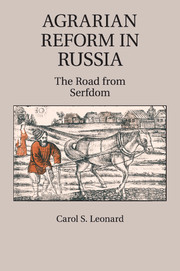Book contents
- Frontmatter
- Contents
- Tables and Figures
- Preface
- Agrarian Reform in Russia
- Introduction
- PART I DILEMMAS OF AGRARIAN REFORM IN RUSSIA
- PART II RUSSIAN LAW AND RURAL ORGANIZATION, 1861–2010
- 4 Property Rights and Customary Law in Rural Russia
- 5 Rural Organization and Entrepreneurship
- PART III RUSSIAN AGRICULTURAL PERFORMANCE, 1861–2010
- APPENDICES
- References
- Index
5 - Rural Organization and Entrepreneurship
Published online by Cambridge University Press: 01 June 2011
- Frontmatter
- Contents
- Tables and Figures
- Preface
- Agrarian Reform in Russia
- Introduction
- PART I DILEMMAS OF AGRARIAN REFORM IN RUSSIA
- PART II RUSSIAN LAW AND RURAL ORGANIZATION, 1861–2010
- 4 Property Rights and Customary Law in Rural Russia
- 5 Rural Organization and Entrepreneurship
- PART III RUSSIAN AGRICULTURAL PERFORMANCE, 1861–2010
- APPENDICES
- References
- Index
Summary
In 1906, the Stolypin reforms granted universal property rights in land, furthering farm formation, which was already occurring in parts of rural Russia. A large number of new farms were created, as M. Davydov (2002) shows, in response to petitions by individual peasant households and collectives. To be sure, many were consolidated by force. It seems clear that family farming was spreading rapidly by the time of the revolution of 1917. Why, then, did this form of farming not last through the 1920s? In accord with the peasant party's own platform in the parliament of 1917, the Bolshevik regime swept away these fragile new property rights in land.
With foresight, Sergei Witte, who was responsible for an earlier reform (1903) abolishing mutual communal responsibility for peasants' infractions (krugovaia poruka), predicted a violent outcome of Stolypin's reforms, which he called a policeman's project. Anger and violence among the peasants, he wrote on January 14, 1912, will not go away. If only compliance had been entirely voluntary and attention had been paid to the conditions of the poorest and ordinary peasants, he rued. Land hunger had driven unrest in 1905, he wrote, when peasants, radicalized by anarchist and Marxist revolutionaries, burned the manor houses and seized the land. The peasants sought access to the fertile land, forests and streams owned by the wealthiest nobles.
- Type
- Chapter
- Information
- Agrarian Reform in RussiaThe Road from Serfdom, pp. 161 - 186Publisher: Cambridge University PressPrint publication year: 2010



